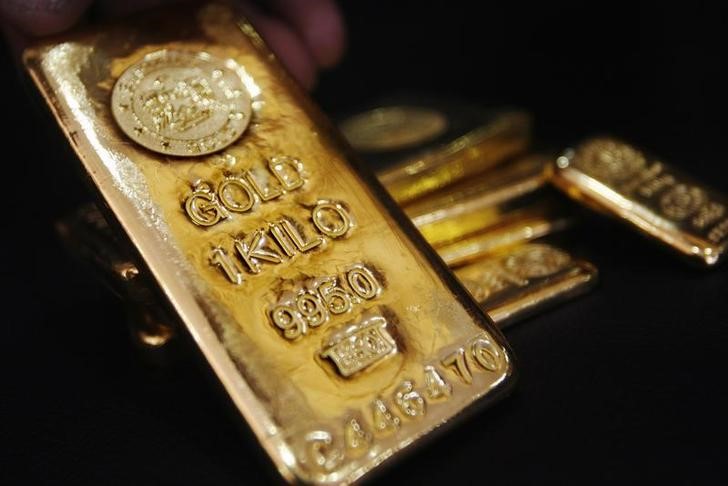By Barani Krishnan
Investing.com - Gold bugs have a problem: The Chinese economy may not be having that much of a problem.
Bullion and futures of gold dipped on Monday, moving in the direction opposite to most commodities, after data suggesting China's manufacturing sector was recovering from a sharp slowdown earlier in the year. Investors had piled into gold in recent months partly on worries that Beijing could announce the smallest economic growth in three decades.
Spot gold, reflective of trades in bullion, was at $1,289.33 an ounce by 1:49 PM ET (17:49 GMT), down $2.85, or 0.2%.
Gold futures for June delivery, traded on the Comex division of the New York Mercantile Exchange, settled the official trading session at $1,294.2, down $4.30, or 0.3%, on the day.
Gold eked out a quarterly gain on Friday as trading for March ended.
Some analysts think the yellow metal is poised for highs of $1,400 and higher this quarter as investors seek hedges against flat interest rates from the Fed and a potential U.S. recession.
"Let us not forget that in 2018, market sentiment flip-flopped back and forth daily between 'risk-on' and 'risk-off' ideology," Walter Pehowich, executive vice-president at Dillon Gage Metals in Addison, Texas, said.
"Every day we continue to see risk in the headlines, whether geopolitical or economic, anything can happen in a moment that will turn markets around," added Pehowich, who sees gold duly returning to above $1,300.
Others, however, think that levels below $1,200 might happen over the next three months, especially with Chinese economic recovery proving more resilient than thought.
China's Caixin/Markit manufacturing purchasing managers' index (PMI) rose to 50.8 from 49.9 in February, data on Monday showed. That was the strongest reading in eight months and followed an uptick in the official PMI, which tracks mainly state-owned enterprises.
The Chinese manufacturing data helped the yield on U.S. 2-year note rise by 3 basis points to 2.29%. Higher yields generally depress demand for gold, a non-interest-bearing safe-haven asset.
A raft of U.S. data is on tap this week, with each release having potential to impact gold prices. Most important will be the March jobs report, due on Friday. Other data include reports on U.S. retail sales and manufacturing.
Palladium, which gained nearly 9% in the first quarter, extended its run higher on Monday to reclaim the $1,400 perch it fell below last week.
The spot price of the silvery-white metal, used for purifying gasoline emissions, rose by $39.20, or 2.8%, to $1,422.80 an ounce. While palladium has remained the world's most expensive traded metal, it fell close to gold last week, trading less than $100 above the yellow metal versus a premium of nearly $300 earlier.
Trades in other Comex metals as of 1:49 PM ET (17:49 GMT):
Palladium futures up $48.40, or 3.6%, at $1,390.20 per ounce.
Platinum futures up 70 cents, or 0.1%, at $854.80 per ounce.
Silver futures down 2 cents, or 0.1%, at $15.09 per ounce.
Copper futures flat at $2.93 per pound.
